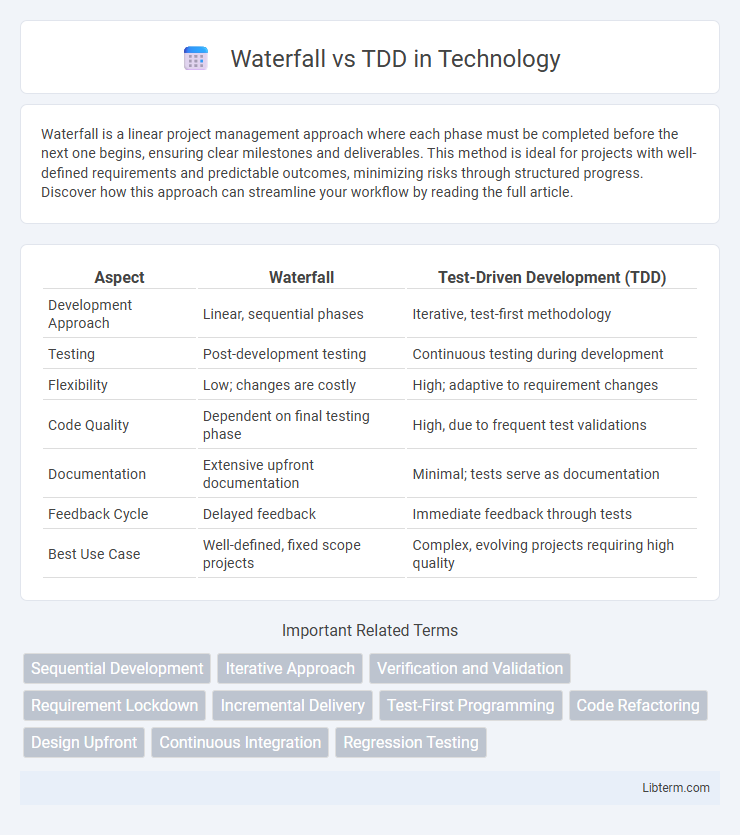Waterfall is a linear project management approach where each phase must be completed before the next one begins, ensuring clear milestones and deliverables. This method is ideal for projects with well-defined requirements and predictable outcomes, minimizing risks through structured progress. Discover how this approach can streamline your workflow by reading the full article.
Table of Comparison
| Aspect | Waterfall | Test-Driven Development (TDD) |
|---|---|---|
| Development Approach | Linear, sequential phases | Iterative, test-first methodology |
| Testing | Post-development testing | Continuous testing during development |
| Flexibility | Low; changes are costly | High; adaptive to requirement changes |
| Code Quality | Dependent on final testing phase | High, due to frequent test validations |
| Documentation | Extensive upfront documentation | Minimal; tests serve as documentation |
| Feedback Cycle | Delayed feedback | Immediate feedback through tests |
| Best Use Case | Well-defined, fixed scope projects | Complex, evolving projects requiring high quality |
Introduction to Waterfall and TDD
Waterfall is a linear and sequential software development methodology where each phase, from requirements gathering to deployment, is completed before the next begins, emphasizing thorough documentation and fixed project scopes. Test-Driven Development (TDD) is an agile practice centered on writing tests before code, promoting iterative development cycles with immediate feedback to ensure functionality meets specified requirements. While Waterfall relies on upfront planning and rigid phase progression, TDD fosters adaptability and continuous integration through automated testing and frequent code refactoring.
Fundamental Principles of Waterfall
The Waterfall model follows a linear and sequential approach where each phase, such as requirements, design, implementation, verification, and maintenance, is completed before moving to the next, ensuring clear documentation and project structure. Its fundamental principles emphasize upfront planning, strict phase boundaries, and minimal overlap between stages to reduce complexity and allow for predictable timelines. This contrasts with Test-Driven Development (TDD), which centers on iterative testing and incremental code development, promoting adaptability and continuous feedback.
Core Concepts of Test-Driven Development (TDD)
Test-Driven Development (TDD) centers on writing automated tests before code implementation, ensuring functionality aligns with defined requirements. This iterative process includes three main phases: writing a failing test, developing code to pass the test, and refactoring for optimization. TDD contrasts with Waterfall methodology by emphasizing continuous testing and incremental progress, reducing defects and improving software quality through early validation.
Key Differences Between Waterfall and TDD
Waterfall methodology follows a linear and sequential design process with distinct phases such as requirements gathering, design, implementation, verification, and maintenance, whereas Test-Driven Development (TDD) emphasizes iterative coding through writing tests before actual code implementation. Waterfall projects often face challenges adapting to changes due to their rigid structure, while TDD promotes flexibility by continuously refining code through frequent test cycles. The primary difference lies in Waterfall's upfront planning versus TDD's test-first approach that integrates development and verification simultaneously.
Advantages of Waterfall Methodology
The Waterfall methodology offers a clear, linear project structure that facilitates straightforward milestones and deliverables, making it easier to manage timelines and resources. It provides comprehensive documentation at each phase, which ensures thorough understanding and traceability of requirements and design decisions. This approach is particularly advantageous for projects with well-defined and stable requirements, minimizing scope changes and enhancing predictability compared to iterative models like Test-Driven Development (TDD).
Benefits of Implementing TDD
Implementing Test-Driven Development (TDD) enhances code quality by promoting early detection of defects and ensuring robust test coverage. TDD facilitates continuous integration and rapid feedback, which accelerates development cycles and reduces maintenance costs. Compared to Waterfall, TDD supports adaptive project management, enabling better alignment with evolving requirements and minimizing costly late-stage changes.
Common Challenges in Waterfall vs TDD
Waterfall projects often face challenges such as inflexibility to changes, delayed testing phases leading to late defect identification, and poor stakeholder feedback integration. In contrast, Test-Driven Development (TDD) encounters issues like increased initial development time, the learning curve for writing effective tests, and potential test maintenance overhead as code evolves. Both methodologies require discipline, but Waterfall struggles with adaptability while TDD emphasizes continuous testing and refactoring to mitigate errors early.
Suitability: When to Choose Waterfall or TDD
Waterfall suits projects with well-defined requirements and fixed scope, such as government contracts or construction projects, where changes are minimal and timings are rigid. Test-Driven Development (TDD) excels in agile environments with evolving requirements, prioritizing continuous testing and iterative code improvements ideal for software startups or innovation-driven teams. Choosing between Waterfall and TDD depends on project complexity, flexibility needs, and the development team's adaptability to change.
Real-World Case Studies: Waterfall vs TDD
Real-world case studies highlight distinct outcomes between Waterfall and Test-Driven Development (TDD) methodologies. In a large-scale financial software project, Waterfall's linear approach resulted in delayed defect detection and increased rework costs, while TDD's iterative testing led to higher code quality and reduced post-release bugs. Another case from an e-commerce platform demonstrated that TDD fostered faster feature delivery and improved team collaboration compared to Waterfall's rigid phase boundaries.
Conclusion: Choosing the Right Approach for Your Project
Selecting between Waterfall and Test-Driven Development (TDD) depends on project flexibility and risk tolerance. Waterfall suits projects with clearly defined requirements and sequential phases, enhancing predictability and documentation. TDD excels in adaptive environments, promoting code quality through continuous testing and rapid feedback, ideal for complex or evolving software demands.
Waterfall Infographic

 libterm.com
libterm.com